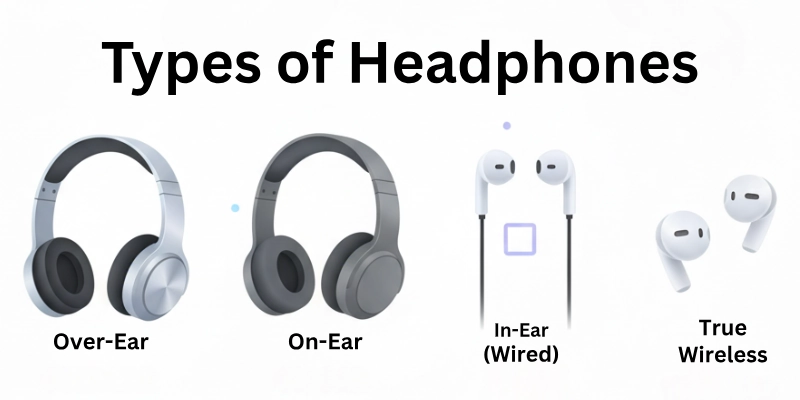Complete Guide to 20 Types of Headphones
Published: 27 Sep 2025
Guys, let me first clear up: what are headphones?
So, headphones are devices worn over the ears to listen to audio without disturbing others. And do you know that there are various types of headphones, each designed for different purposes and preferences?
Exactly, yes! In this blog post, we’ll explore these different types, helping you understand which ones best suit your needs.
Types of Headphones
Headphones come in various shapes and sizes, from classic over-ear designs to compact in-ear models.

So, guys, here are the 20 main categories of headphones you should know about:
- Over-Ear Headphones
- On-Ear Headphones
- In-Ear Headphones
- Earbuds
- Open-Back Headphones
- Closed-Back Headphones
- Noise-Canceling Headphones
- Wireless Headphones
- Bluetooth Headphones
- True Wireless Earbuds
- Bone Conduction Headphones
- Electrostatic Headphones
- Planar Magnetic Headphones
- Gaming Headphones
- Studio Headphones
- Sports Headphones
- DJ Headphones
- Portable Headphones
- Smart Headphones
- Wired Headphones
Let’s dive in next to cover each type in detail.
1. Over-Ear Headphones
Over-Ear Headphones are large headphones with cushioned ear cups that fully cover your ears. They provide excellent sound quality and isolation by enclosing the ears completely. They often come with adjustable headbands designed for comfort during long listening sessions.
Pros:
- Superior sound quality
- Excellent noise isolation
- Comfortable for long use
- Great bass response
Cons:
- Bulky and heavy
- Not very portable
- Can cause ear sweat
- Often more expensive
Best for:
- Home listening
- Studio recording
- Gaming
- Audiophiles
2. On-Ear Headphones
On-Ear Headphones are smaller headphones with ear cups that sit directly on your ears rather than enclosing them. They are lighter and more portable than over-ear headphones, while still providing good sound quality. Many on-ear headphones come with foldable designs and adjustable headbands for better comfort and portability.
Pros:
- Lightweight and portable
- Less ear sweat
- Decent sound quality
- Foldable designs available
Cons:
- Less noise isolation
- Can be uncomfortable
- Sound leakage possible
- Less bass response
Best for:
- Commuting
- Office use
- Casual listening
- Travel
3. In-Ear Headphones
In-Ear Headphones, also known as earbuds or in-ear monitors (IEMs), are small headphones that fit snugly inside the ear canal. They are highly portable and lightweight, making them popular for use with smartphones and portable music players. In-ear headphones often come with different sizes of ear tips to ensure a comfortable and secure fit.
Pros:
- Extremely portable
- Lightweight and discreet
- Good noise isolation
- Suitable for active use
Cons:
- Can be uncomfortable for some
- Sound quality varies
- Limited bass response
- Ear tips may need replacement
Best for:
- Traveling
- Exercise and sports
- Commuting
- Everyday use
4. Earbuds
Earbuds are small, lightweight headphones that rest on the outer ear or inside the ear canal without completely sealing it. They are often connected by a wire and are designed for portability and convenience, typically used with smartphones, MP3 players, and other portable devices.
Pros:
- Extremely portable
- Lightweight and compact
- Easy to use and store
- Affordable options available
Cons:
- Limited noise isolation
- Less secure fit
- Can fall out easily
- Generally lower sound quality
Best for:
- Casual listening
- Hands-free calls
- Jogging and exercise
- Budget-conscious users
5. Open-Back Headphones
Open-Back Headphones are designed with ear cups that have perforations or vents on the outer shell. This design allows air and sound to pass through, creating a more natural and spacious sound experience.
Pros:
- Natural and spacious sound
- Breathable design
- Minimal ear fatigue
- Accurate sound representation
Cons:
- Sound leakage
- No isolation from external noise
- Not suitable for noisy environments
- Limited bass response
Best for:
- Home listening
- Studio mixing and mastering
- Critical listening
- Audiophiles
6. Closed-Back Headphones
Closed-Back Headphones are designed with ear cups that are fully sealed, preventing sound from escaping and isolating the listener from external noise. They provide a more immersive listening experience by blocking out noise and enhancing bass frequencies.
Pros:
- Excellent noise isolation
- Enhanced bass response
- Minimal sound leakage
- Versatile for different environments
Cons:
- Can cause ear heat/sweat
- Potential for ear fatigue
- Soundstage may feel closed
- Some models can be bulky
Best for:
- Commuting and travel
- Recording and monitoring
- Gaming and immersive audio
- Noisy environments
7. Noise-Canceling Headphones
Noise-Canceling Headphones are equipped with technology that actively reduces external noise using microphones and electronic circuitry. They can significantly diminish sounds like airplane engines or office chatter, enhancing the clarity of audio playback.
Pros:
- Effective noise reduction
- Enhanced audio clarity
- Comfortable for long use
- Great for travel and work
Cons:
- Expensive compared to regular headphones
- Battery-powered (require charging)
- Sound quality may vary
- Some users experience pressure sensation
Best for:
- Airplane travel
- Commuting on public transport
- Office and work environments
- Concentrating in noisy places
8. Wireless Headphones
Wireless Headphones are headphones that connect to audio sources (like smartphones or computers) via Bluetooth or other wireless technologies, eliminating the need for a physical cable.
Pros:
- Freedom from wires
- Convenient and portable
- Easy pairing with devices
- Modern and stylish designs
Cons:
- Requires charging
- Potential for audio lag
- Battery life varies
- Generally more expensive
Best for:
- Active lifestyles
- Commuting and travel
- Gym and exercise
- Everyday use
9. Bluetooth Headphones
Bluetooth Headphones are wireless headphones that use Bluetooth technology to connect to audio devices like smartphones, tablets, or computers. They allow for seamless connectivity without the need for physical cables, providing freedom of movement and convenience. Bluetooth headphones come in various styles, including over-ear, on-ear, and in-ear models, catering to different preferences and uses.
Pros:
- Wireless convenience
- Easy pairing with devices
- Versatile for different activities
- Improved battery life in newer models
Cons:
- Requires charging
- Possible audio latency
- Compatibility issues sometimes
- Higher price for advanced features
Best for:
- Commuting and travel
- Exercise and workouts
- Hands-free calling
- Everyday listening
10. True Wireless Earbuds
True Wireless Earbuds are small, lightweight headphones that have no wires whatsoever. Each earbud operates independently and connects wirelessly to the audio source (like a smartphone) via Bluetooth. They come with a charging case that doubles as a storage case and battery charger for the earbuds.
Pros:
- Completely wire-free
- Ultra-portable and compact
- Convenient charging case
- Suitable for active use
Cons:
- Shorter battery life per charge
- Risk of losing individual earbuds
- Audio quality can vary
- More expensive than wired options
Best for:
- On-the-go listening
- Exercise and sports
- Commuting and travel
- Minimalist audio setup
11. Bone Conduction Headphones
Bone Conduction Headphones work by sending sound vibrations through the cheekbones directly to the inner ear, bypassing the eardrums. They leave the ear canal open, allowing users to hear background sounds alongside audio from the headphones. This technology is beneficial for those who need to stay aware of their surroundings while listening to music or taking calls.
Pros:
- Allows awareness of surroundings
- Comfortable for long-term wear
- Suitable for hearing-impaired users
- Doesn’t cover ears, reducing ear fatigue
Cons:
- Sound quality may not match traditional headphones
- Limited bass response
- Not ideal for noisy environments
- Can be more expensive for high-quality models
Best for:
- Outdoor activities (running, cycling)
- Hearing aids compatibility
- Situations requiring situational awareness
- Users prone to ear discomfort
12. Electrostatic Headphones
Electrostatic Headphones use a different technology than traditional headphones. They operate by placing a thin electrically charged diaphragm between two perforated metal plates, which vibrates to produce sound. This design allows for extremely detailed and accurate sound reproduction, favored by audiophiles for its clarity and low distortion.
Pros:
- Exceptional sound clarity
- Low distortion
- Detailed audio reproduction
- Lightweight diaphragm for fast response
Cons:
- Require specialized amplifiers
- Expensive compared to other types
- Fragile construction
- Limited availability and selection
Best for:
- Audiophiles seeking high-fidelity sound
- Critical listening and studio mastering
- Quiet environments for optimal performance
- Those willing to invest in audio quality
13. Planar Magnetic Headphones
Planar Magnetic Headphones utilize a different driver technology compared to traditional headphones. They feature a thin, lightweight diaphragm with a circuit of magnets placed evenly across its surface. When an electric current passes through these magnets, the diaphragm moves to create sound. This design results in improved bass response, reduced distortion, and a more accurate sound reproduction.
Pros:
- Enhanced bass and treble response
- Low distortion and high resolution
- Wide soundstage
- Durable construction
Cons:
- Generally larger and heavier
- Can be more expensive
- Require adequate amplification
- Limited availability of models
Best for:
- Audiophiles and music enthusiasts
- Studio monitoring and mixing
- Detailed and critical listening
- Users appreciating technical innovation
14. Gaming Headphones
Gaming Headphones are designed specifically for gaming purposes, offering features to enhance the gaming experience. They typically include features like surround sound, noise isolation, and a built-in microphone for in-game communication. Gaming headphones often have a sturdy build and comfortable ear cups for long gaming sessions.
Pros:
- Clear communication with built-in mic
- Comfortable for extended wear
- Durable construction for gaming environments
Cons:
- Can be bulky and less portable
- Higher-end models can be expensive
Best for:
- Competitive gaming
- Team communication in multiplayer games
- Immersive gaming experiences
- Long gaming sessions
15. Studio Headphones
Studio Headphones are designed for professional audio monitoring and recording in studio environments. They prioritize accuracy and detail in sound reproduction. Studio headphones typically have a balanced sound profile and durable construction to withstand long hours of use.
Pros:
- Accurate sound reproduction
- Neutral sound profile
- Comfortable for extended wear
- Durable and reliable build quality
Cons:
- Often bulky and less portable
- May not emphasize bass for casual listening
- Higher-end models can be expensive
- Sound preferences may vary by user
Best for:
- Music production and mixing
- Recording vocals and instruments
- Critical listening and audio editing
- Professional use in studio environments
16. Sports Headphones
Sports Headphones are designed for active individuals engaging in physical activities like running, cycling, or working out. They prioritize features such as sweat resistance, secure fit, and durability to withstand movement and sweat. Sports headphones often come with ear hooks or fins and may include wireless connectivity for freedom of movement.
Pros:
- Sweat-resistant for active use
- Secure fit to stay in place
- Lightweight and comfortable
- Wireless options for freedom
Cons:
- Sound quality may vary
- Limited noise isolation
- Ear fatigue during extended use
- Battery life may be shorter
Best for:
- Running and jogging
- Gym workouts and fitness classes
- Outdoor activities like hiking or cycling
- Users needing hands-free functionality
17. DJ Headphones
DJ Headphones are specifically designed for DJs and music professionals who require precise audio monitoring and durability in loud environments such as clubs and events.
Pros:
- Rotating ear cups for DJ monitoring
- Excellent noise isolation
- Durable construction
- Clear and balanced sound
Cons:
- Can be bulky and heavy
- May prioritize durability over comfort
- Higher cost for professional models
- Sound preferences may vary by DJ
Best for:
- DJing and live performances
- Cueing and mixing tracks
- Professional use in clubs and events
18. Portable Headphones
Portable Headphones are designed for on-the-go use, emphasizing lightweight construction, compact size, and ease of storage. They are suitable for use with smartphones, MP3 players, and other portable devices, offering convenience without compromising on sound quality and comfort.
Pros:
- Lightweight and compact
- Easy to carry and store
- Good sound quality for size
- Versatile for daily use
Cons:
- May lack advanced features
- Limited noise isolation
- Build quality may vary
- Sound leakage possible
Best for:
- Commuting and travel
- Daily use with portable devices
- Casual listening on the move
- Users seeking convenience
19. Smart Headphones
Smart Headphones integrate advanced technology and connectivity features beyond traditional audio playback. They often include built-in sensors, voice assistants (like Siri or Google Assistant), touch controls, and app integration for personalized settings and notifications. Smart headphones aim to enhance user experience with connectivity and functionalities.
Pros:
- Built-in sensors for activity tracking
- Voice assistant integration
- Touch controls for easy operation
- App connectivity for customization
Cons:
- Higher cost compared to basic headphones
- Potential for increased battery usage
- Complexity in setup and use
- May have limited compatibility with devices
Best for:
- Users interested in smart features
- Fitness tracking and health monitoring
- Hands-free control with voice assistants
- Tech-lovers
20. Wired Headphones
Wired Headphones use a physical cable to connect to audio sources such as smartphones, computers, or audio equipment. They transmit audio signals directly through the cable, ensuring stable connectivity and consistent sound quality without relying on wireless technology.
Pros:
- Stable and reliable audio connection
- No need for battery charging
- Generally lower cost
- Wide availability and variety
Cons:
- Limited mobility due to cable
- Potential for tangling
- Less convenient for on-the-go use
- Limited reach compared to wireless
Best for:
- Audio professionals and purists
- Studio monitoring and critical listening
- Gaming and latency-sensitive applications
- Users preferring consistent audio quality
Conclusion
In this article, we’ve explored a variety of headphone types. We started by defining each type and highlighting their unique features. Among the most commonly used are wireless headphones for their convenience and freedom of movement, and in-ear headphones for their compact size and versatility.
Advice:
When choosing headphones, consider your lifestyle, activities, and audio preferences. Opt for noise-canceling features for travel or work, and prioritize comfort for extended wear. For gaming or studio use, look for headphones with specific features like surround sound or neutral sound profiles.
Well, if you have any questions or need further clarification, feel free to leave a comment below. Your feedback and insights are always appreciated!
FAQs
Here are some most commonly asked questions related to the headphone types.
Headphones are devices you wear over or in your ears to listen to audio from devices like smartphones or music players. They come in different types for various uses, from casual listening to professional use.
Here are some pros and cons of headphones:
- Pros: Easy to use, affordable, widely available, no need for charging, and offer decent sound quality for everyday listening.
- Cons: Usually wired, limited features like noise cancellation or wireless connectivity, and might not offer the best sound isolation.
Noise-canceling headphones are ideal for travel because they block out airplane noise and let you enjoy music without distractions.
It depends on your needs. Wireless headphones offer freedom but need charging, while wired ones provide reliable sound without battery worries.
Sports headphones with a secure fit and sweat resistance are great for running, ensuring they stay in place and handle sweat.
Over-ear headphones cover your ears completely for better sound isolation, while on-ear headphones rest on your ears for a lighter feel.
Yes, gaming headphones can be used for music. They often have good sound quality and are comfortable for long listening sessions.
Studio headphones are designed for accurate sound reproduction, making them great for music production and critical listening.
Noise-canceling headphones can help you focus by reducing background noise, making them beneficial for studying or working in noisy environments.
In-ear headphones are safe when used properly. Choose the right size ear tips to ensure a comfortable fit without causing discomfort.
Headphones with a built-in microphone are perfect for phone calls. Look for ones with clear voice quality and noise isolation.
True wireless earbuds are compact, wire-free, and great for on-the-go use. They come with a charging case and are easy to carry around.

- Be Respectful
- Stay Relevant
- Stay Positive
- True Feedback
- Encourage Discussion
- Avoid Spamming
- No Fake News
- Don't Copy-Paste
- No Personal Attacks

- Be Respectful
- Stay Relevant
- Stay Positive
- True Feedback
- Encourage Discussion
- Avoid Spamming
- No Fake News
- Don't Copy-Paste
- No Personal Attacks





